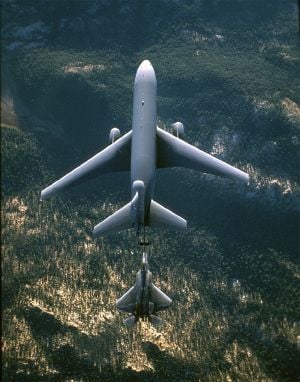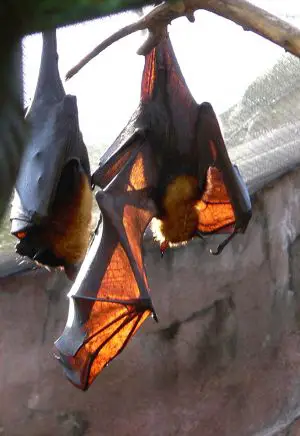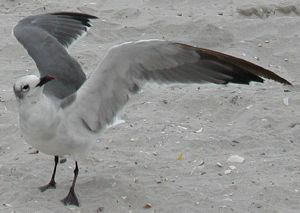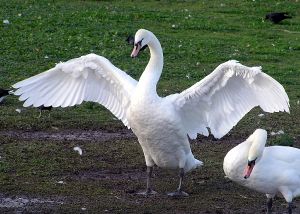Wing

A wing is a surface used to produce lift and therefore flight, for travel in the air or another gaseous medium. The wing shape is usually an airfoil. The first use of the word was for the foremost limbs of birds, but has been extended to include the wings of insects, bats and pterosaurs and also man-made devices.
A wing is a device for generating lift. Its aerodynamic quality, expressed as a Lift-to-drag ratio, can be up to 60 on some gliders. This means that a significantly smaller thrust force can be applied to propel the wing through the air in order to obtain a specified lift.
Use
A common use of wings is in flight, using forward motion to create vertical lift, but wings are also used to produce downforce holding racing cars on the ground. A sail boat moves by using sails and a keel like a vertical wings to produce lift (in the horizontal plane).
Artificial wings
- 737-700w.gif
Wing of a Boeing 737]]
- Aircraft wing flaps small dsc06830.jpg
Flaps partially deployed
- Aircraft wing flaps full dsc06835.jpg
Full flaps
- Aircraft wing flaps full airbrakes dsc06838.jpg
Full flaps, with spoilers deployed.
- Leading edge: the front edge of the wing
- Trailing edge: the back edge of the wing
- Span: distance from wing tip to wing tip
- Chord: distance from wing leading edge to wing trailing edge, usually measured parallel to the long axis of the fuselage
- Aspect ratio: ratio of span to standard mean chord
- Aerofoil (or Airfoil in US English): the shape of the top and bottom surfaces when viewed as cross sections cut from leading edge to trailing edge.
- Sweep angle: the angle between the perpendicular to the design centreline of the wing in the wing plane, and either the leading edge or ¼ chord line.
- Twist: gradual change of the airfoil (aerodynamic twist) and/or angle of incidence of the wing cross-sections (geometrical twist) along the span.
Design features
Aeroplane wings may feature some of the following:
- A rounded (rarely sharp) leading edge cross-section
- A sharp trailing edge cross-section
- Leading-edge devices such as slats, slots, or extensions
- Trailing-edge devices such as flaps
- Ailerons (usually near the wingtips) to provide roll control
- Spoilers on the upper surface to disrupt lift and additional roll control
- Vortex generators to help prevent flow separation
- Wing fences to keep flow attached to the wing
- Dihedral, or a positive wing angle to the horizontal. This gives inherent stability in roll. Anhedral, or a negative wing angle to the horizontal, has a destabilising effect
- Folding wings allow more aircraft to be carried in the confined space of the hangar of an aircraft carrier.
Wing types
- Swept wings are wings that are bent back at an angle, instead of sticking straight out from the fuselage.
- Forward-swept wings are bent forward, the reverse of a traditional swept wing. Forward swept wings have been used in some two seat gliders, and in the experimental X-29.
- Elliptical wings (technically wings with an elliptical lift distribution) are theoretically optimum for efficiency at subsonic speeds. A good example of this wing type can be seen on the British Supermarine Spitfire World War II fighter aircraft.
- Delta wings have reasonable performance at subsonic and supersonic speeds and are good at high angles of attack. For examples see the F-102, F-106, Avro Vulcan and B-58.
- Waveriders are efficient supersonic wings that take advantage of shock waves. For an example, see the XB-70.
- Rogallo wings are two partial cone sections arranged with the apexes together and the convex side up. One of the simplest wings to construct using cloth or other membrane material and a frame.
- Swing-wings (or variable geometry wings) are able to move in flight to give the benefits of dihedral and delta wing. Although they were originally proposed by German aerodynamicists during the 1940s, they are now only found on military aircraft such as the Grumman F-14, Panavia Tornado, General Dynamics F-111, B-1 Lancer, Tupolev Tu-160, MiG-23 and Sukhoi Su-24.
- Ring wings are optimally loaded closed lifting surfaces with higher aerodynamic efficiency than planar wings having the same aspect-ratios. Other nonplanar wing systems display an aerodynamic efficiency intermediate between ring wings and planar wings.
- Oblique wing
- Flying wing
- Blended wing body
Science of wings
The science of wings is one of the principal applications of the science of aerodynamics. However, at the simplest level, a wing operates by generating a greater pressure below the wing than above it. Pressure and force are directly related; higher pressure equals higher force. When enough force is applied below the wing, flight can take place. This, however is not due to the unequal path explanation commonly given. Despite popular belief, flat plates at angles and curved airfoils do not generate lift in different ways. They both, in fact, use Bernoulli's principle to generate lift. On a flat plate, there is a dividing point on the bottom surface, forward of which, the air must curl back and over the leading edge of the airfoil. This, in incompressible flow (a good approximation below Mach .6) results in the airflow over the top moving faster, at the same density, inducing a lower relative pressure. In aerodynamics the actual lift generated by an airfoil is found by integrating the area between the upper surface Cp and lower surface Cp from the front of the wing to the back. Each Cp is the relative pressure (pressure at some infinitely small point) minus the pressure of the free stream air (the condition before the air is affected by the airfoil) divided by dynamic pressure. [1]
It was at one point believed that lift over a wing would be produced through the molecules of air colliding with the surface, and imparting some of their momentum to it, having been deflected somewhat downward from their initial path. This theory, however, also proves, conclusively, that flight is impossible, as the lift created would be insignificant when compared to the drag induced. The equation arrived at through a Newtonian model of lift is L=ρ*V²*sin² α*cos α. (see Newton's Third Law). The fundamental flaw with this being that it does not account for upstream effects seen in airflows.
The science of wings applies in other areas beyond conventional fixed-wing aircraft, including:
- Helicopters which use a rotating wing with a variable pitch or angle to provide a directional force
- The space shuttle which uses its wings only for lift during its descent
- Some racing cars, especially Formula One cars, which use upside-down wings to give cars greater adhesion at high speeds
- Sailing boats which use sails as vertical wings with variable fullness and direction to move across water.
Structures with the same purpose as wings, but designed to operate in liquid media, are generally called fins or hydroplanes, with hydrodynamics as the governing science. Applications arise in craft such as hydrofoils and submarines. Sailing boats use both fins and wings.
Animal wings

Biologists believe that animal wings evolved at least four separate times, an example of convergent evolution.
- insect wings are believed to have evolved between 300 and 400 million years ago
- pterosaur wings at least 225 million years ago
- bird wings at least 150 million years ago
- bat wings about 55 million years ago.
Wings in these groups are analogous structures because they evolved independently rather than being passed from a common ancestor.
See also
- Flight
- Bird flight
- Pinion (feather)
- Planform
- Wings in the enneagram
External links
- Why wings generate lift
- Demystifying the Science of Flight - Audio segment on NPR's Talk of the Nation Science Friday
- NASA's explanations and simulations
- Advanced Topics in Aerodynamics Wings for all speeds
- Evolution of flight in animals
- Explanation invoking Coanda Effect
Credits
New World Encyclopedia writers and editors rewrote and completed the Wikipedia article in accordance with New World Encyclopedia standards. This article abides by terms of the Creative Commons CC-by-sa 3.0 License (CC-by-sa), which may be used and disseminated with proper attribution. Credit is due under the terms of this license that can reference both the New World Encyclopedia contributors and the selfless volunteer contributors of the Wikimedia Foundation. To cite this article click here for a list of acceptable citing formats.The history of earlier contributions by wikipedians is accessible to researchers here:
The history of this article since it was imported to New World Encyclopedia:
Note: Some restrictions may apply to use of individual images which are separately licensed.
- ↑ Anderson, John. Introduction to Flight. 5. New York: McGraw-Hill, 2005.




